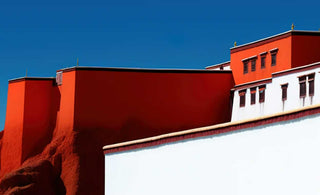
The origin and history of Sho Dun Festiaval
The Sho Dun Festival, also known as the "Yoghurt Festival" or "Dharma Festival," holds a revered place in Tibetan culture and heritage. Its origins trace back to the 8th century during the reign of King Trisong Detsen of Tibet. Rooted deeply in Buddhist traditions, this festival is celebrated with great zeal and devotion, marking the end of the monks' summer retreat.
Legend has it that Guru Padmasambhava, also known as Guru Rinpoche, played a pivotal role in the inception of the Sho Dun Festival. During the festival, he demonstrated his mystical powers by performing miraculous acts, revitalizing dying crops and resurrecting livestock. This miraculous feat earned the festival its name, "Sho Dun," which translates to "Yoghurt Banquet," as the locals offered yogurt to commemorate Guru Rinpoche's blessings on this day.
Historically, the Sho Dun Festival was initially observed as an offering to monastic communities by the local king to replenish their depleted resources after the summer retreat. The king provided the monks with offerings of food, including yogurt, marking the end of their fasting period. Over the centuries, this ritual evolved into an annual celebration, gaining deeper religious and cultural significance.
The rituals and ceremonies during the Sho Dun Festival symbolize the dawning of new beginnings. The festivity coincides with the first harvest in Tibet, celebrating the abundance of crops and marking the transition from summer to autumn. The joyful ambiance resonates as locals and monks come together to participate in various religious rites, cultural performances, and colorful processions.
Each day of the Sho Dun Festival holds its unique significance. The first day commences with the unfolding of the thangka, a sacred Buddhist painting, at the Drepung Monastery, accompanied by a grand ceremony. This ceremony attracts numerous locals and tourists alike, seeking blessings and witnessing the spectacular unveiling of the thangka.
Subsequent days are marked by vibrant performances, traditional Tibetan opera, masked dances known as cham, and the mesmerizing illumination of butter lamps. The illumination of butter lamps signifies the dispelling of darkness and the triumph of light over ignorance, signifying the teachings of Buddha.
The Sho Dun Festival stands as a testament to the rich cultural heritage of Tibet, blending religious fervor, artistic expression, and communal celebration. Its history intertwines with the teachings of Buddhism and showcases the resilience and spirit of the Tibetan people. This age-old festival continues to captivate audiences worldwide, drawing attention to the profound cultural legacy of oriental art and tradition.
Vibrant colors of the Sho Dun Festival
The festival grounds transform into a captivating canvas adorned with meticulously crafted decorations. From intricate tapestries to ornate banners and colorful prayer flags fluttering in the breeze, every detail contributes to a stunning visual spectacle.
Ritualistic Attire: Participants don traditional attire, each garment a masterpiece of color symbolism. The vivid tones, such as saffron, crimson, and azure, hold profound cultural meanings, representing elements like purity, spirituality, and the natural world.
Colorful Performances: Dancers clad in resplendent costumes move gracefully, their attire resonating with the festival's jubilant atmosphere. The vivid swirls of their dresses and the bold strokes of their accessories add an enchanting dimension to the festivities.
Symbolism of Colors: The vibrant palette isn't merely for aesthetic pleasure; each shade carries symbolic weight. Red signifies energy and good fortune, while yellow embodies prosperity and harmony. Blue and green hues evoke tranquility and the sacredness of nature, fostering a sense of peace and reverence.
Thematic Significance: The interplay of colors isn't arbitrary but intricately woven into the festival's thematic elements. From the vibrant processionals to the intricately designed artwork, every color serves as a thread in the rich tapestry of Sho Dun's traditions.
Age-old traditions and rituals
Central to the Sho Dun Festival are the elaborate religious ceremonies conducted by Buddhist monks. The festivities commence with the unfurling of the Thangka, a large silk painting of the Buddha, displayed at the Drepung Monastery. This iconic event marks the beginning of a week-long celebration. Throughout the festival, monks perform intricate cham dances, characterized by vibrant costumes and masks symbolizing various deities and spirits. These dances are believed to purify the surroundings, ward off evil, and bring blessings to the spectators.
Offerings and Practices: An integral part of the Sho Dun Festival is the offering of yogurt, marking the transition from the summer retreat of the monks. Locals and pilgrims present offerings of yogurt to the monks, symbolizing good fortune, purity, and the end of the fasting period.
Another significant ritual involves the lighting of butter lamps. These lamps, made from yak butter, illuminate the monasteries, temples, and homes, signifying the dispelling of darkness and the spread of wisdom.
At Oriental Aesthetics, we stand as stewards of classical oriental art, dedicated to providing systematic, high-quality professional services to both oriental artists and enthusiasts worldwide. Our platform serves as a nexus, connecting collectors, artists, and art lovers who appreciate the beauty and depth of classical oriental art. Through our curated collection, expert guidance, and seamless services, we aim to elevate the experience of appreciating and acquiring oriental art, fostering a deeper understanding and admiration for this timeless oriental heritage.
























